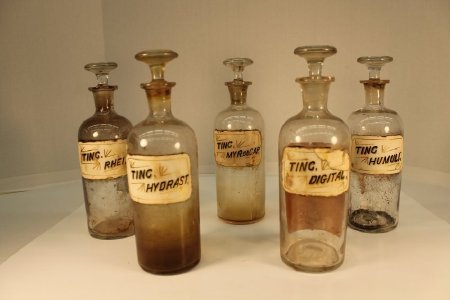Object ID Number:
PH116
Object Name:
Bottles
Type:
Shop Furniture
Manufactured from:
1850
Manufactured to:
1950
Description / History:
There are five glass bottles in this set. They are dated between 1850 and 1950. Each bottles has a glass stopper and a label under a thin layer of glass. They have smaller, tincture mouth openings. The bottles are empty but the labels indicate that all were tincture medications, meaning that they were prepared by dissolving a drug in alcohol.
Bottle A: Has the label "Tinc. Hydrast." The common name is Tincture of Goldenseal. This drug acts on mucous membranes to relax them. It was used to reduce inflammation of tissues with mucous membranes such as the nose, colon, and rectum.
Bottle B: Has the label "Tinc. Digital" which stands for Tincture of Digitalis. It was used as a cardiac stimulant. An additional sticker label on the back reads that this medication was prepared on March 20, 1942. The average adult dose was 1 cc every 15 min as directed. This bottle holds one pint or 475 cc. This medication was produced by Eli Lilly & Company, a leading pharmaceutical manufacurer located in Indianapolis, Indiana.
Bottle C: Has the label "Tinc. Rhei". The common name for this drug is Tincture of Rhubarb. It was medicinally used as a cathartic to treat indigestion and constipation.
Bottle D: Has the label "Tinc. Myr.et.Cap." which is short for Tincture of Myrrh and Capsicum. Also termed "Hot Drops", this drug was primarily used externally on sprains, bruises, fresh wounds, cuts, and rheumatism.
Bottle E: Has the label "Tinc Humuli". The common name for this drug is Hopa Tincture. It was medicinally used as a narcotic to treat gout and rheumatism.
Bottle A: Has the label "Tinc. Hydrast." The common name is Tincture of Goldenseal. This drug acts on mucous membranes to relax them. It was used to reduce inflammation of tissues with mucous membranes such as the nose, colon, and rectum.
Bottle B: Has the label "Tinc. Digital" which stands for Tincture of Digitalis. It was used as a cardiac stimulant. An additional sticker label on the back reads that this medication was prepared on March 20, 1942. The average adult dose was 1 cc every 15 min as directed. This bottle holds one pint or 475 cc. This medication was produced by Eli Lilly & Company, a leading pharmaceutical manufacurer located in Indianapolis, Indiana.
Bottle C: Has the label "Tinc. Rhei". The common name for this drug is Tincture of Rhubarb. It was medicinally used as a cathartic to treat indigestion and constipation.
Bottle D: Has the label "Tinc. Myr.et.Cap." which is short for Tincture of Myrrh and Capsicum. Also termed "Hot Drops", this drug was primarily used externally on sprains, bruises, fresh wounds, cuts, and rheumatism.
Bottle E: Has the label "Tinc Humuli". The common name for this drug is Hopa Tincture. It was medicinally used as a narcotic to treat gout and rheumatism.
Dimensions:
H–9.25 Dia–2.75 inches
